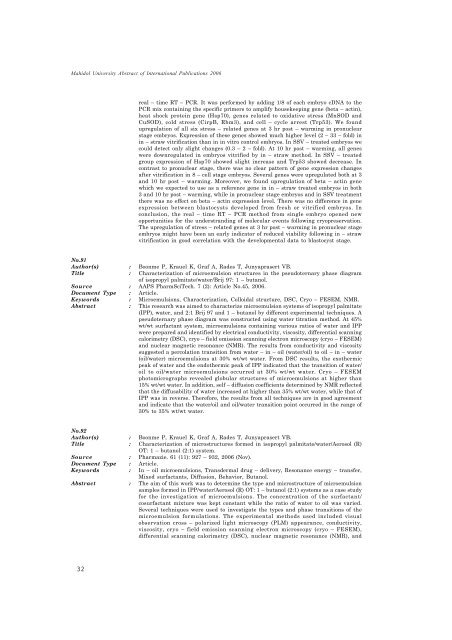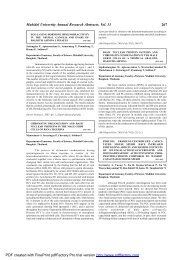2006 ที่น้องแอนทำ.pmd - Mahidol University
2006 ที่น้องแอนทำ.pmd - Mahidol University
2006 ที่น้องแอนทำ.pmd - Mahidol University
You also want an ePaper? Increase the reach of your titles
YUMPU automatically turns print PDFs into web optimized ePapers that Google loves.
<strong>Mahidol</strong> <strong>University</strong> Abstract of International Publications <strong>2006</strong><br />
32<br />
real – time RT – PCR. It was performed by adding 1/8 of each embryo cDNA to the<br />
PCR mix containing the specific primers to amplify housekeeping gene (beta – actin),<br />
heat shock protein gene (Hsp70), genes related to oxidative stress (MnSOD and<br />
CuSOD), cold stress (CirpB, Rbm3), and cell – cycle arrest (Trp53). We found<br />
upregulation of all six stress – related genes at 3 hr post – warming in pronuclear<br />
stage embryos. Expression of these genes showed much higher level (2 – 33 – fold) in<br />
in – straw vitrification than in in vitro control embryos. In SSV – treated embryos we<br />
could detect only slight changes (0.3 – 2 – fold). At 10 hr post – warming, all genes<br />
were downregulated in embryos vitrified by in – straw method. In SSV – treated<br />
group expression of Hsp70 showed slight increase and Trp53 showed decrease. In<br />
contrast to pronuclear stage, there was no clear pattern of gene expression changes<br />
after vitrification in 8 – cell stage embryos. Several genes were upregulated both at 3<br />
and 10 hr post – warming. Moreover, we found upregulation of beta – actin gene<br />
which we expected to use as a reference gene in in – straw treated embryos in both<br />
3 and 10 hr post – warming, while in pronuclear stage embryos and in SSV treatment<br />
there was no effect on beta – actin expression level. There was no difference in gene<br />
expression between blastocysts developed from fresh or vitrified embryos. In<br />
conclusion, the real – time RT – PCR method from single embryo opened new<br />
opportunities for the understranding of molecular events following cryopreservation.<br />
The upregulation of stress – related genes at 3 hr post – warming in pronuclear stage<br />
embryos might have been an early indicator of reduced viability following in – straw<br />
vitrification in good correlation with the developmental data to blastocyst stage.<br />
No.91<br />
Author(s) : Boonme P, Krauel K, Graf A, Rades T, Junyaprasert VB.<br />
Title : Characterization of microemulsion structures in the pseudoternary phase diagram<br />
of isopropyl palmitate/water/Brij 97: 1 – butanol.<br />
Source : AAPS PharmSciTech. 7 (2): Article No.45, <strong>2006</strong>.<br />
Document Type : Article.<br />
Keywords : Microemulsions, Characterization, Colloidal structure, DSC, Cryo – FESEM, NMR.<br />
Abstract : This research was aimed to characterize microemulsion systems of isopropyl palmitate<br />
(IPP), water, and 2:1 Brij 97 and 1 – butanol by different experimental techniques. A<br />
pseudoternary phase diagram was constructed using water titration method. At 45%<br />
wt/wt surfactant system, microemulsions containing various ratios of water and IPP<br />
were prepared and identified by electrical conductivity, viscosity, differential scanning<br />
calorimetry (DSC), cryo – field emission scanning electron microscopy (cryo – FESEM)<br />
and nuclear magnetic resonance (NMR). The results from conductivity and viscosity<br />
suggested a percolation transition from water – in – oil (water/oil) to oil – in – water<br />
(oil/water) microemulsions at 30% wt/wt water. From DSC results, the exothermic<br />
peak of water and the endothermic peak of IPP indicated that the transition of water/<br />
oil to oil/water microemulsions occurred at 30% wt/wt water. Cryo – FESEM<br />
photomicrographs revealed globular structures of microemulsions at higher than<br />
15% wt/wt water. In addition, self – diffusion coefficients determined by NMR reflected<br />
that the diffusability of water increased at higher than 35% wt/wt water, while that of<br />
IPP was in reverse. Therefore, the results from all techniques are in good agreement<br />
and indicate that the water/oil and oil/water transition point occurred in the range of<br />
30% to 35% wt/wt water.<br />
No.92<br />
Author(s) : Boonme P, Krauel K, Graf A, Rades T, Junyaprasert VB.<br />
Title : Characterization of microstructures formed in isopropyl palmitate/water/Aerosol (R)<br />
OT: 1 – butanol (2:1) system.<br />
Source : Pharmazie. 61 (11): 927 – 932, <strong>2006</strong> (Nov).<br />
Document Type : Article.<br />
Keywords : In – oil microemulsions, Transdermal drug – delivery, Resonance energy – transfer,<br />
Mixed surfactants, Diffusion, Behavior, Butanol.<br />
Abstract : The aim of this work was to determine the type and microstructure of microemulsion<br />
samples formed in IPP/water/Aerosol (R) OT: 1 – butanol (2:1) systems as a case study<br />
for the investigation of microemulsions. The concentration of the surfactant/<br />
cosurfactant mixture was kept constant while the ratio of water to oil was varied.<br />
Several techniques were used to investigate the types and phase transitions of the<br />
microemulsion formulations. The experimental methods used included visual<br />
observation cross – polarized light microscopy (PLM) appearance, conductivity,<br />
viscosity, cryo – field emission scanning electron microscopy (cryo – FESEM),<br />
differential scanning calorimetry (DSC), nuclear magnetic resonance (NMR), and
















